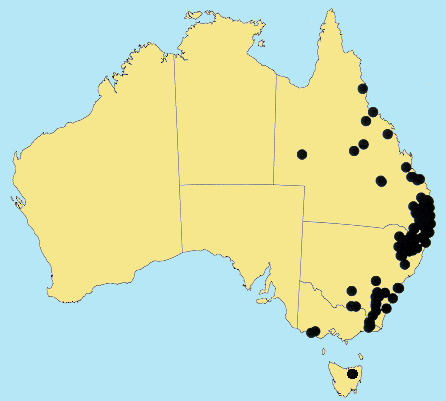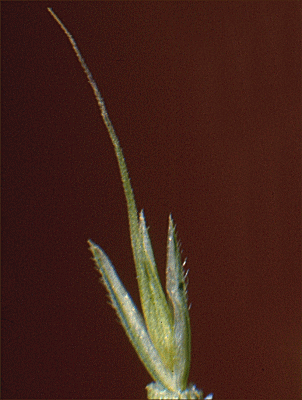Cenchrus purpurascens Thunb., Trans. Linn. Soc. London 2: 329 (1794)
Classification. (GPWG 2001) : Subfamily Panicoideae. Paniceae.
Type of Basionym or Protologue Information: LT: (LINN-80.1). LT designated by Veldkamp in Cafferty et al., Taxon 49(2): 253 (2000).
Recent synonyms: P. compressum, P. alopecuroides. Cenchrus compressus
Key references (books and floras): [1810]. R.Brown, Prodromus (195 as Pennisetum compressum), [1878] G.Bentham, Flora Australiensis 7 (495 as Pennisetum compressum), [2002] D.Sharp & B.K.Simon, AusGrass, Grasses of Australia as Pennisetum alopecuroides, [2008] S.W.L.Jacobs, R.D.B.Walley & D.J.B.Wheeler, Grasses of New South Wales (332) as Pennisetum alopecuroides.
Illustrations: [1984] N.T.Burbidge. rev. S.W.L.Jacobs, Australian Grasses (205, as Pennisetum alopecuroides), [2008] S.W.L.Jacobs, R.D.B.Whalley & D.J.B.Wheeler, Grasses of New South Wales, 4th edn (332 as Pennisetum alopecuroides).
Habit. Perennial. Rhizomes present. Stolons absent. Culms erect, 60–100 cm tall. Mid-culm nodes glabrous. Leaves mostly basal. Leaf-sheaths glabrous on surface. Ligule a fringe of hairs, 0.5–0.75 mm long. Leaf-blades erect or drooping, flat or conduplicate or involute, 10–45 cm long, 3–6 mm wide.
Inflorescence. Inflorescence solid, a panicle. Panicle linear, 7–20 cm long, 1–1.5 cm wide.
Spikelets. Spikelets sessile, 1–2 in the cluster. Involucre composed of bristles. Fertile spikelets 2-flowered, the lower floret barren (rarely male), the upper fertile, comprising 1 basal sterile florets, comprising 1 fertile floret(s), without rachilla extension, lanceolate, terete, 6–8 mm long.
Glumes. Glumes dissimilar, thinner than fertile lemma. Lower glume orbicular, hyaline, without keels, 0 -nerved. Upper glume oblong, membranous, without keels, 5–7 -nerved. Florets. Basal sterile florets 1, barren, without significant palea. Lemma of lower sterile floret 100 % of length of spikelet, chartaceous, 7 -nerved.
Fertile lemma 6–8 mm long, without keel, 5–7 -nerved. Anthers 3. Grain 2.5–3 mm long.
Continental Distribution: Temperate Asia, Tropical Asia, Australasia, and Pacific.
Australian Distribution: Queensland, New South Wales, Victoria.
Queensland: Darling Downs, Moreton, Port Curtis, South Kennedy, Wide Bay, Leichhardt. New South Wales: North Coast, Central Coast, South Coast, Northern Tablelands, Central Tablelands, Southern Tablelands, North-Western Slopes, Central-Western Slopes, South-Western Slopes, South-Western Plains. Victoria: East Gippsland, Volcanic Plain.
Notes. The Victorian plants are beleived to be introduced.
In tropical and subtropical wet sclerophyll forests, dry sclerophyll forests, Brigalow forests, tropical and subtropical sub-humid woodlands, and temperate sub-humid woodlands. Flowers Jan.-June.







